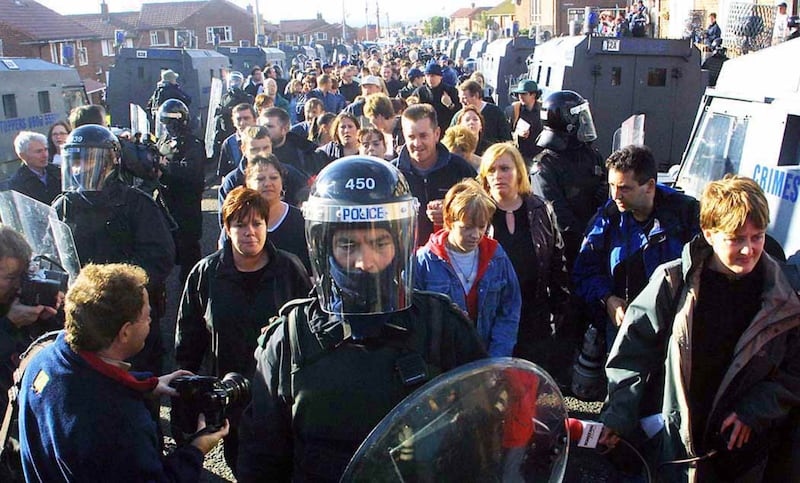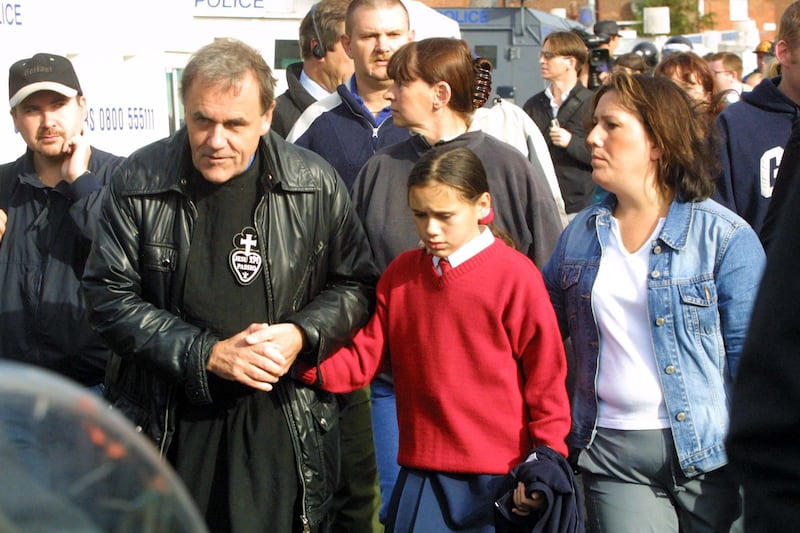Few images of The Troubles leave a greater memory.
The little girl cowering as she went to the Holy Cross primary school flanked by police who struggled to shield her from abuse, even urine-filled balloons.
The protest by Protestant loyalists began at the Ardoyne Road school in North Belfast in June 2001, but it rapidly escalated when pupils came back in September after the summer holidays.
Files now released by Northern Ireland’s Public Records Office reveal the fears then held by politicians and officials that scores of other schools faced similar blockades.
READ MORE
Even today, the causes of the dispute are argued about. In the eyes of some, it began after loyalists from the Glenbryn estate put up Union Jack flags on Ardoyne Road in June. They were quickly countered by a group of young republicans. Violence erupted. For days, Holy Cross pupils faced anger from Glenbryn residents.
On the fourth day, a blast bomb was thrown at parents and children going to Holy Cross, with one local loyalist community leader demanding that the school close because “this is a loyalist community”.

The protests resumed in September, with protests centred around the school during the day, and riots in the evening. The dispute ended largely by Christmas, with the promise of tighter security and investment in Glenbryn.
Hundreds of pages of files now released show later attempts by Stormont officials to get both sides to agree plans for road changes, walls and fencing to deter future riots, along with improvements to community services. Sixty-nine houses in Glenbryn Park/Alliance Avenue were chosen for extra security, including the installation of solid rear doors, metal grilles and laminated glass.
Months of talks took place over the changes, with Glenbryn residents unhappy that a planned roundabout does not attempt to meet Glenbryn’s “basic aim” of protection from “mob attacks up the road”. The level of detail illustrated by the files is striking, with repeated discussions about the height and shape of hedges and walls that could or should block line of sight for locals. Without a peace wall, small incidents involving local youths could quickly spiral out of control, leading to some becoming “habituated to engaging in recreational rioting”, the report says.

Meanwhile, residents from the Catholic Lower Ardoyne were unhappy that some of the changes to local roads demanded by Glenbryn residents were going ahead, refusing to agree unless the latter agreed to wider community dialogue. In one letter in April 2002, Mary Bunting, director of equality in the office of the first and deputy first minister, said Stormont must help to sort out social and economic problems in the district.
However, locals had responsibilities to sort out their “relationship problems” too.
“While we can offer assistance the responsibility lies with them. This is a tough message, but one which will have to be made,” she said.
Later in April, there were several “altercations” between residents and parents outside Holy Cross school, and violence taking place in the district in the evenings. The Co Wicklow-born priest Fr Aidan Troy, who had come to international prominence during the protests, voiced local suspicions that Glenbryn had won on the changes to local roads. Former IRA volunteer Gerard McGuigan voiced concerns that a wall to run around “Protestant houses at the corner of Alliance Avenue” was too high and would deny local Catholics a full line of sight on the road.

Meanwhile, the Protestant Concerned Residents of Upper Ardoyne (CRUA) had moved away from wanting a wall “completely across the line” of the existing road, arguing that they were offering “a major concession”. The Catholic neighbours accepted the need for a wall to protect some of the Protestant houses, but they wanted it placed “tight up against the houses”, a plan rejected by CRUA.
By now, a clear sense of frustration is evident from the files left by the officials dealing with the issue when they outlined options for Stormont ministers in April 2002. Every option came with problems, though overriding the Lower Ardoyne residents was particularly sensitive since “it’s important to remember from a PR point of view that the Holy Cross school community has strong support”.
By August, arbitrators reported on the divisions, with Upper Ardoyne residents insisting that their Catholic neighbours on the Lower Ardoyne had agreed to changes, but then reneged upon them. Meanwhile, the Lower Ardoyne residents believed that their Protestant neighbours “were promised at an early stage that they would get what they want, and this had left little room for negotiation”.
“It is not necessarily the case that people were intentionally trying to deceive each other. However, due to the high level of mistrust and the lack of direct communication, it is not surprising that the sides are so far apart,” they reported.
In the end, officials urged the North’s then first minister David Trimble and deputy first minister Mark Durkan to sign off on a plan that would see a wall built along the Alliance Avenue side. That would “disrupt the sightlines” for young rioters, while not interfering with the view available for young children walking to the primary school, if the measures were backed up by closed-circuit TV cameras.













